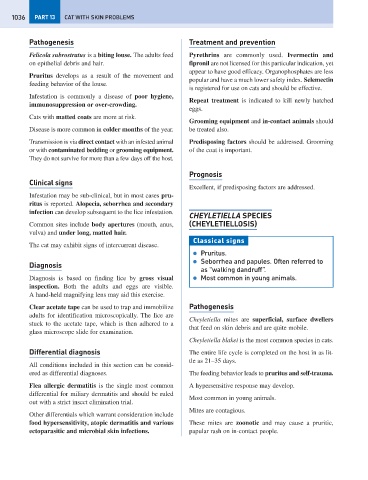Page 1044 - Problem-Based Feline Medicine
P. 1044
1036 PART 13 CAT WITH SKIN PROBLEMS
Pathogenesis Treatment and prevention
Felicola subrostratus is a biting louse. The adults feed Pyrethrins are commonly used. Ivermectin and
on epithelial debris and hair. fipronil are not licensed for this particular indication, yet
appear to have good efficacy. Organophosphates are less
Pruritus develops as a result of the movement and
popular and have a much lower safety index. Selemectin
feeding behavior of the louse.
is registered for use on cats and should be effective.
Infestation is commonly a disease of poor hygiene,
Repeat treatment is indicated to kill newly hatched
immunosuppression or over-crowding.
eggs.
Cats with matted coats are more at risk.
Grooming equipment and in-contact animals should
Disease is more common in colder months of the year. be treated also.
Transmission is via direct contact with an infested animal Predisposing factors should be addressed. Grooming
or with contaminated bedding or grooming equipment. of the coat is important.
They do not survive for more than a few days off the host.
Prognosis
Clinical signs
Excellent, if predisposing factors are addressed.
Infestation may be sub-clinical, but in most cases pru-
ritus is reported. Alopecia, seborrhea and secondary
infection can develop subsequent to the lice infestation.
CHEYLETIELLA SPECIES
Common sites include body apertures (mouth, anus, (CHEYLETIELLOSIS)
vulva) and under long, matted hair.
Classical signs
The cat may exhibit signs of intercurrent disease.
● Pruritus.
● Seborrhea and papules. Often referred to
Diagnosis
as “walking dandruff”.
Diagnosis is based on finding lice by gross visual ● Most common in young animals.
inspection. Both the adults and eggs are visible.
A hand-held magnifying lens may aid this exercise.
Clear acetate tape can be used to trap and immobilize Pathogenesis
adults for identification microscopically. The lice are
Cheyletiella mites are superficial, surface dwellers
stuck to the acetate tape, which is then adhered to a
that feed on skin debris and are quite mobile.
glass microscope slide for examination.
Cheyletiella blakei is the most common species in cats.
Differential diagnosis The entire life cycle is completed on the host in as lit-
tle as 21–35 days.
All conditions included in this section can be consid-
ered as differential diagnoses. The feeding behavior leads to pruritus and self-trauma.
Flea allergic dermatitis is the single most common A hypersensitive response may develop.
differential for miliary dermatitis and should be ruled
Most common in young animals.
out with a strict insect elimination trial.
Mites are contagious.
Other differentials which warrant consideration include
food hypersensitivity, atopic dermatitis and various These mites are zoonotic and may cause a pruritic,
ectoparasitic and microbial skin infections. papular rash on in-contact people.

